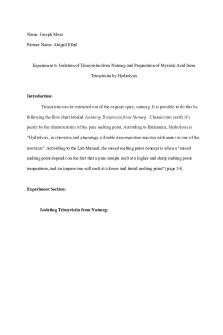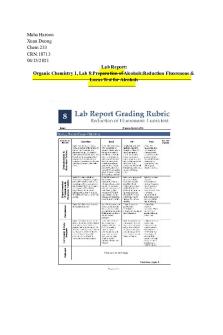Post Lab Report 7 PDF

| Title | Post Lab Report 7 |
|---|---|
| Author | Abigail Finch |
| Course | Organic Chemistry Laboratory II |
| Institution | University of South Florida |
| Pages | 8 |
| File Size | 354.6 KB |
| File Type | |
| Total Downloads | 38 |
| Total Views | 149 |
Summary
lab report...
Description
Experiment 7: Friedel Crafts Acylation of Ferrocene Introduction Background Friedel-Crafts alkylation reactions involve the addition of an alkyl group to an aromatic ring. The conditions for this reaction necessitate an alkyl halide and aromatic ring as reactants, and a lewis acid catalyst such as AlCl3 or FeCl3. The lewis acid is necessary as it activates the alkyl halide to become a better electrophile. An example of this reaction is the reaction that occurs between ethyl chloride and benzene in the presence of aluminium chloride to produce ethyl-benzene and hydrochloric acid. Friedel-Crafts acylation is a very similar process. In F-C acylation, an acyl halide is used to add an acetyl group to an aromatic ring. Again, a lewis acid such as AlCl3 or FeCl3 is used to make the acyl halide into a better electrophile. An electrophilic aromatic substitution reaction occurs in which an acetyl-aromatic group and an HX group are created. An example of this reaction is the formation of acetylbenzene from benzene and acetyl chloride, catalyzed by aluminum chloride. Figure 1: Mechanism of Reaction
Figure 2: Possible Side Reactions
Experimental Section Table 1: Flow Chart Summary of the Experiment
Friedel-Crafts Reaction Procedure Experimental...
Reaction workup...
Column chromatography...
Pipet-column…
Product analysis...
+clean test tube +93 mg ferrocene +.35 mL acetic anhydride +.1 85% H3PO4 +TLC +warm steam +heat 10 min +TLC until only a small amount ferrocene is left
+cool in ice +.5 mL H2O +3M NaOH +collect Hirsch +wash w/cold water +dry, weigh, % yield +TLC +MP
+micropipet +wool to bottom +1g alumina +layer of sand +fill with hexanes +transfer crude +carefully bulb +avoid column running dry using hexane
+run flash chromatography +collect yellow (ferrocene) +switch solvent system to 1:1 hexane:diethyl ether +collect orange (acetylferrocene)
+TLC on fractions 1 & 2 +calc Rf +evaporate, vacuum +obtain mass +calculate percent yield +determine melting point +obtain H NMR
Experimental Procedure -I n a small test tube, add 93 mg ferrocene, .35 mL acetic anhydride, and .1 mL phosphoric acid. Perform initial TLC. Cap the tube and warm in a steam bath while stirring for 10 minutes. Take secondary TLC, continue if needed. Cool the test tube in ice.
-Add .5 mL ice water to the test tube dropwise while stirring. Add 3M NaOH dropwise until the mixture is neutral (use litmus paper). Collect with a Hirsch funnel, wash with water, and dry with filter paper. Save a sample for melting point and TLC analysis. -Using a pasteur pipet, prepare a microscale column by putting a small plug of glass wool, 1g alumina, a layer of sand, and hexanes throughout the column. Place fraction 1 Erlenmeyer flask underneath. -Dissolve the crude product in hexanes and put it into the column. Wash with a few drops of diethyl ether. Add a 50:50 mixture of hexanes to diethyl ether to the column before it dries. Collect this in fraction 2 Erlenmeyer flask. -Spot new TLC of the two fractions and crude product. Evaporate the solvent of the two fractions using an aspirator. Dry, weigh, and record melting points. Dissolve 20 mg of the pure product in CDCl3 and run an H NMR. Table of Chemicals Table 2: Analysis of the Chemicals in the Experiment Name
Ferrocene
Phosphoric acid
Acetic anhydride
Hexanes
Formula
C10H10Fe
H3PO4
C4H6O3
C6H14
Molar mass (g/mol)
186.04
97.994
102.09
86.18
Boiling point (°C)
249
158
139.8
69
Melting point (°C)
172.5
40
-73.1
-95.3
Structure
Hazards
-flammable solid -may cause skin, eye, respiratory irritation -may be harmful if swallowed -may cause blood abnormalities -heat sensitive -liver damage
-causes severe skin burns and eye damage -may be corrosive to metals
-flammable liquid and vapor -harmful if swallowed -causes severe skin burns and eye damage -toxic if inhaled
-flammable liquids -chronic hazards to the aquatic environment -aspiration hazard -reproductive toxicity -skin irritant -STOT following single exposure
Results Table 3: Results from the Experiment Physical properties
Unreacted ferrocene
Acetylferrocene
Crude acetylferrocene
Melting point
173-174 °C
84-86 °C
140-150 °C
Weight
0.032 g
0.025 g
0.058 g
Rf
.769
.436
.439
Calculations Percent yield =
actual value theoretical value
Actual value: 0.025 g
x 100%
Theoretical value: 0.114 g
Percent yield =
Moles ferrocene = moles Acetylferrocene 0.093 g ferrocene x
1 mol f errocene 186.04 g/mol
.0005 mol Acetylferrocene x
Rf value =
= .0005 mol ferrocene
228.07 g/mol 1 mol Acetylf errocene
distance travelled by molecule distance travelled by solvent
= .114 g Acetylferrocene
.025g x .114g
100% = 21.9%
Distance travelled by the solvent: 3.9 cm Distance travelled by the ferrocene: 3 cm Distance travelled by the product (Acetylferrocene) : 1.7 cm
ferrocene =
3 cm 3.9 cm
= 0.769
product (Acetylferrocene) =
Spectroscopy Figure 1: Experimental H-NMR Spectrum
Figure 2: Theoretical H-NMR Spectrum for Acetylferrocene
1.7 cm 3.9 cm =
0.436
Discussion The literature value for the melting point of ferrocene is 173 °C; the experimental value for the unreacted ferrocene was measured to be 173-174 °C. This value indicates that the sample truly was ferrocene. The literature value for acetylferrocene is 85-86 °C. The experimental values for the crude and pure acetylferrocene products were 140-150 °C and 84-86 °C, respectively. This indicates a high level of impurity in the crude product as well as a great level of efficiency in the purification process, as the purified product is exactly in line with the literature value. The final purified product was determined to be .025 g, with the theoretical yield being .114 g. With this information, the percent yield of the purified acetylferrocene was calculated to be 21.9%. The low yield is inefficient but not unexpected, as the reaction workup and purification processes undoubtedly saw a lot of product loss to experimental factors. Possible sources include loss due to washing, drying, filtering, evaporation and column chromatography. TLC was taken several times during the experiment to monitor the course of the reaction. The TLC for this reaction confirmed the appearance of the desired product. The Rf value for ferrocene was calculated to be .769, while the pure product acetylferrocene had an Rf of .436. This confirms the reaction progression as we would have expected the product acetylferrocene to travel less distance. The course of the reaction could also be monitored, as the crude product showed two different spots with different Rf values (one for the unreacted ferrocene and one for the desired product acetylferrocene). In the purified TLC, only one spot (for the desired product) remained. The H-NMR spectrum also helped identify the product as acetylferrocene because of the great similarities between the theoretical and experimental spectra. In theory, acetylferrocene should show 4 distinct peaks as opposed to 1 peak for ferrocene. The experimental H NMR follows the
predicted outcome with a peak at 2.5 ppm for the CH3 protons, a peak at 4.6 ppm for the protons on the ring closest to the acetyl, a peak at 4.8 ppm for the protons further but still on the same ring, and lastly, a peak at 4 ppm for the protons on the ring without the acetyl group. The closer the protons are to the acetyl group, the more deshielded, and the lower the ppm will be. Together, the melting points, H-NMR, and TLC support the appearance of the desired product, acetylferrocene. Question 1: The spectrum shows four distinct peaks. The most downfield is the most deshielded, therefore peak 1 around 4.8 ppm with an integration of 2 represents the two b protons (those furthest from the acetyl group). Peak 2 is the second most downfield and represents the two a protons (closest to the acetyl group). Peak 3 around 4 ppm represents the five c protons on the unsubstituted ring. Lastly, peak 4 around 2.5 ppm represents the three d protons on the methyl. Question 2: The melting point was 75-78 °C, which does not match the literature value for acetylferrocene and suggests contamination from another substance. The H NMR has the same peaks 1,2, and 4 but a different integration of peak 3, 15 instead of 5. This suggests that the H NMR is displaying results from both ferrocene and acetylferrocene, as 10 more protons in the unsubstituted ring will register from ferrocene. Therefore, this experiment failed to properly see the reaction to completion and some of the ferrocene was left unreacted. Conclusion In this experiment, acetylferrocene was successfully synthesized from ferrocene . The data including the percent yield, melting point, TLC, and H NMR spectrum of the product all supported the appearance of the desired product. The H NMR spectra displayed all the characteristic peaks of acetylferrocene. The techniques performed in this lab could be utilized in various other fields where alkylation or acylation needed, such as in industrial synthesis,
medicinal practices, and experimental research. Overall, the lab succeeded in its goal to perform a Friedel-Crafts acylation reaction and produce acetylferrocene. References Schaller, Chris. “Friedel-Crafts Acylation.” Chemistry LibreTexts. Libretexts, June 5, 2019. Solomon, and Weldegirma. “Experiment 6: Nitration of Methyl Benzoate.” Experimental Organic Chemistry, Laboratory Manual, 9 ed, (2020). J.R. Mohrig, C.N. Hammond and P.F. Schatz, Techniques in Organic Chemistry , Freeman Publishers, 2nd Edition....
Similar Free PDFs

Post Lab Report 7
- 8 Pages

Post Lab - lab report
- 2 Pages

Post Lab Report 10
- 8 Pages

Post lab report 4
- 12 Pages

Post Lab Report Lab 5
- 5 Pages

Post Lab 7 Instrructions
- 3 Pages

Experiment 4 Post-Lab Report
- 8 Pages

Experiment 8 Post-Lab Report
- 15 Pages

Post Lab report 10 Wittig
- 10 Pages

Post lab 7 - Grade: A
- 4 Pages

LAB Report 2 - Post Lab Question
- 2 Pages

SCC 202-Lab#2-Post Lab Report
- 9 Pages

Orgo Post-lab 8 - Orgo- Lab report
- 14 Pages

Lab 7 post lab focus q\'s
- 2 Pages
Popular Institutions
- Tinajero National High School - Annex
- Politeknik Caltex Riau
- Yokohama City University
- SGT University
- University of Al-Qadisiyah
- Divine Word College of Vigan
- Techniek College Rotterdam
- Universidade de Santiago
- Universiti Teknologi MARA Cawangan Johor Kampus Pasir Gudang
- Poltekkes Kemenkes Yogyakarta
- Baguio City National High School
- Colegio san marcos
- preparatoria uno
- Centro de Bachillerato Tecnológico Industrial y de Servicios No. 107
- Dalian Maritime University
- Quang Trung Secondary School
- Colegio Tecnológico en Informática
- Corporación Regional de Educación Superior
- Grupo CEDVA
- Dar Al Uloom University
- Centro de Estudios Preuniversitarios de la Universidad Nacional de Ingeniería
- 上智大学
- Aakash International School, Nuna Majara
- San Felipe Neri Catholic School
- Kang Chiao International School - New Taipei City
- Misamis Occidental National High School
- Institución Educativa Escuela Normal Juan Ladrilleros
- Kolehiyo ng Pantukan
- Batanes State College
- Instituto Continental
- Sekolah Menengah Kejuruan Kesehatan Kaltara (Tarakan)
- Colegio de La Inmaculada Concepcion - Cebu

